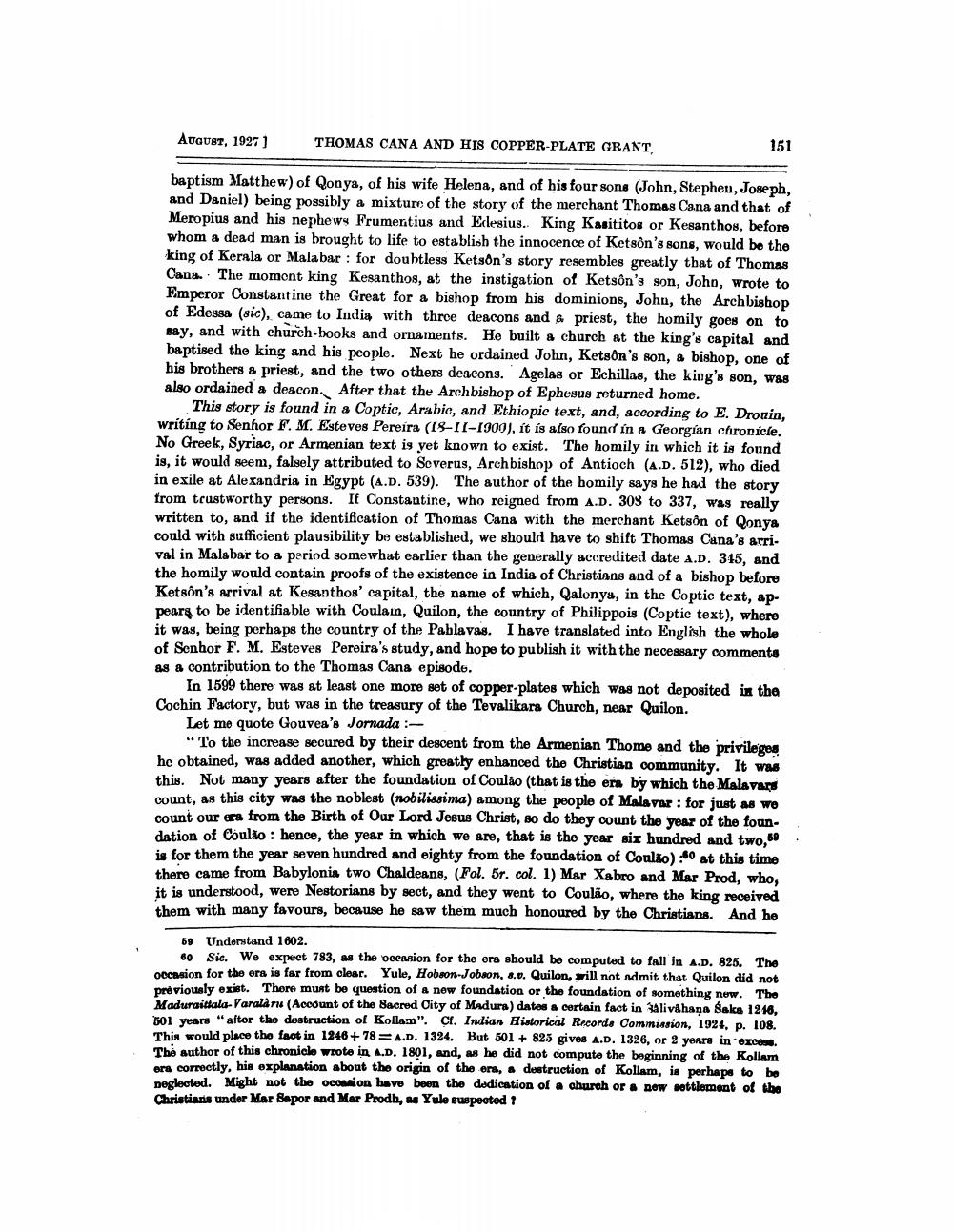________________
AUGUST, 1927]
THOMAS CANA AND HIS COPPER-PLATE GRANT
baptism Matthew) of Qonya, of his wife Helena, and of his four sons (John, Stephen, Joseph, and Daniel) being possibly a mixture of the story of the merchant Thomas Cana and that of Meropius and his nephews Frumentius and Edesius. King Kasititos or Kesanthos, before whom a dead man is brought to life to establish the innocence of Ketsôn's sons, would be the king of Kerala or Malabar: for doubtless Ketson's story resembles greatly that of Thomas Cana. The moment king Kesanthos, at the instigation of Ketsôn's son, John, wrote to Emperor Constantine the Great for a bishop from his dominions, John, the Archbishop of Edessa (sic), came to India, with three deacons and & priest, the homily goes on to say, and with church-books and ornaments. He built a church at the king's capital and baptised the king and his people. Next he ordained John, Ketsôn's son, a bishop, one of his brothers a priest, and the two others deacons. Agelas or Echillas, the king's son, was also ordained a deacon. After that the Archbishop of Ephesus returned home.
This story is found in a Coptic, Arabic, and Ethiopic text, and, according to E. Drouin, writing to Senhor F. M. Esteves Pereira (18-11-1900), it is also found in a Georgian chronicle. No Greek, Syriac, or Armenian text is yet known to exist. The homily in which it is found is, it would seem, falsely attributed to Severus, Archbishop of Antioch (A.D. 512), who died in exile at Alexandria in Egypt (A.D. 539). The author of the homily says he had the story from trustworthy persons. If Constantine, who reigned from A.D. 308 to 337, was really written to, and if the identification of Thomas Cana with the merchant Ketson of Qonya could with sufficient plausibility be established, we should have to shift Thomas Cana's arrival in Malabar to a period somewhat earlier than the generally accredited date A.D. 315, and the homily would contain proofs of the existence in India of Christians and of a bishop before Ketson's arrival at Kesanthos' capital, the name of which, Qalonya, in the Coptic text, appears to be identifiable with Coulam, Quilon, the country of Philippois (Coptic text), where it was, being perhaps the country of the Pablavas. I have translated into English the whole of Senhor F. M. Esteves Pereira's study, and hope to publish it with the necessary comments as a contribution to the Thomas Cana episode.
151
In 1599 there was at least one more set of copper-plates which was not deposited in the Cochin Factory, but was in the treasury of the Tevalikara Church, near Quilon.
Let me quote Gouvea's Jornada :
"To the increase secured by their descent from the Armenian Thome and the privileges he obtained, was added another, which greatly enhanced the Christian community. It was this. Not many years after the foundation of Coulão (that is the era by which the Malavars count, as this city was the noblest (nobilissima) among the people of Malavar: for just as we count our era from the Birth of Our Lord Jesus Christ, so do they count the year of the foundation of Coulão: hence, the year in which we are, that is the year six hundred and two,69 is for them the year seven hundred and eighty from the foundation of Coulão):80 at this time there came from Babylonia two Chaldeans, (Fol. 5r. col. 1) Mar Xabro and Mar Prod, who, it is understood, were Nestorians by sect, and they went to Coulão, where the king received them with many favours, because he saw them much honoured by the Christians. And he
59 Understand 1602.
60 Sic. We expect 783, as the occasion for the era should be computed to fall in A.D. 825. The occasion for the era is far from clear. Yule, Hobson-Jobson, 8.v. Quilon, will not admit that Quilon did not previously exist. There must be question of a new foundation or the foundation of something new. The Maduraitiala-Varalaru (Account of the Sacred City of Madura) dates a certain fact in 3alivahana Saka 1216, 501 years "after the destruction of Kollam". Ct. Indian Historical Records Commission, 1924, p. 108. This would place the fact in 1246+78=A.D. 1324. But 501 + 825 gives A.D. 1326, or 2 years in excess. The author of this chronicle wrote in A.D. 1801, and, as he did not compute the beginning of the Kollam era correctly, his explanation about the origin of the era, a destruction of Kollam, is perhaps to be neglected. Might not the occasion have been the dedication of a church or a new settlement of the Christians under Mar Sapor and Mar Prodh, as Yule suspected ?




